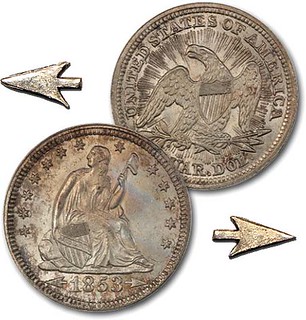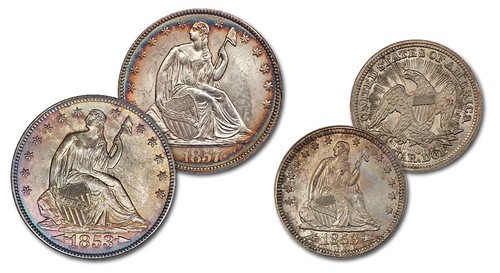
PREV ARTICLE
NEXT ARTICLE
FULL ISSUE
PREV FULL ISSUE
LIBERTY SEATED ARROWS EXAMINEDA Greysheet article by Greg Reynolds examines the "arrows at date" feature of Liberty Seated coinage and speculates on the reason for the removal of arrows by 1856. Here's an excerpt - see the complete article online for more information. -Editor
From 1856 until 1873, the silver content of silver coins continued to be in line with the Coinage Act of 1853. A law in 1873 led to the restoration of arrows on dimes, quarters and half dollars for reasons that are different from the reason that arrows were added to Liberty Seated coins, except silver dollars, in 1853. Should arrows have continued in place after 1855 to indicate that post-1853 silver coins were specified to contain less silver than pre-1853 Liberty Seated silver coins of the same respective denominations and design types? The reason for the reduction in silver content relates to the value ratio of silver to gold. The Coinage Act of 1792 established an official government ratio of silver to gold of 15:1. There was an official U.S. government policy of bimetallism, meaning both gold and silver were underpinnings of the monetary system. The U.S. dollar was based on the Eight Reales silver coin (Spanish Milled Dollar) of the Spanish Empire. Even so, one U.S. Dollar was defined as a weight in silver and separately as a weight in gold, with the idea that U.S. silver coins and U.S. gold coins would be interchangeable and that deposits of silver or gold could be freely exchanged at the mint for coins. The U.S. Mint then accepted deposits in silver and gold and minted coins for the depositors. While the official government ratio stayed the same, the market ratio of the value of silver to the value of gold fluctuated. By the early 1830s, it became financially worthwhile for speculators in the U.S. to sell U.S. gold coins to traders in Europe for amounts greater than the face values of the respective coins. In the early 1830s, U.S. gold coins almost entirely disappeared from circulation in the U.S. The official government ratio of silver to gold was changed by law in 1834 from 15:1 to 16:1. In other words, the value of one Troy ounce of gold was increased to sixteen Troy ounces of silver. Gold was legislated to be worth more than it was before, and the gold content of each new U.S. gold coin was thus reduced so gold coins would be spent rather than melted or exported. This change in ratio was an adjustment to market realities. In the early 1850s, an opposite scenario manifested itself. The free market exchange rate of silver to gold dropped below 16:1. The value of one unit of weight of silver increased to the point that it was significantly above one-sixteenth (0.0625) of one unit of weight of gold. The value of gold decreased because massive quantities of gold were discovered in California in 1849. In the early 1850s, the value of silver as bullion rose to the point that silver coins were worth more in bullion terms than their respective face values. For example, the silver in ten half dollars was worth more than one half eagle (U.S. $5 gold coin). By the early 1850s, there was a massive shortage of silver coins in circulation; very few people spent them in the United States.
To read the complete article, see:
Wayne Homren, Editor The Numismatic Bibliomania Society is a non-profit organization promoting numismatic literature. See our web site at coinbooks.org. To submit items for publication in The E-Sylum, write to the Editor at this address: whomren@gmail.com To subscribe go to: https://my.binhost.com/lists/listinfo/esylum All Rights Reserved. NBS Home Page Contact the NBS webmaster 
|


